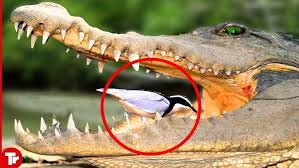The Unique Relationship Between Crocodiles and Plover Birds: A Mutual Bond of Trust
In the wild, some animal relationships are based on survival, while others are driven by cooperation and mutual benefit. One fascinating example of this kind of relationship is between the crocodile and the plover bird. While these two creatures might seem like an unlikely pair, they share a bond that highlights the beauty of nature’s interconnections. This article explores the unique relationship between crocodiles and plover birds, and how it demonstrates the power of symbiosis in the animal kingdom.
The Players: Crocodiles and Plover Birds
Before diving into their relationship, let’s first get to know the two animals involved. The crocodile is a large, carnivorous reptile that can be found in rivers, lakes, and marshes across many parts of the world. These apex predators are known for their powerful jaws and sharp teeth, which they use to capture and consume prey. Despite their ferocious nature, crocodiles spend much of their time basking in the sun, lying motionless on riverbanks or floating in the water

On the other hand, the plover bird is a small, brightly colored bird commonly found near water bodies like lakes, beaches, and marshes. Plover birds are known for their cheerful songs and their habit of flitting around the water’s edge in search of food, particularly insects and small invertebrates.
The Symbiotic Relationship
The relationship between crocodiles and plover birds is a textbook example of mutualism, a form of symbiosis in which both species benefit from the interaction. In this case, the plover bird helps the crocodile by cleaning its teeth, while the crocodile provides the bird with food and safety.
Here’s how it works:
- The Crocodile’s Need for Cleaning: Crocodiles have teeth that are sharp and covered in food residue, which can attract bacteria. Left unchecked, these bacteria could lead to infections or other health problems. However, crocodiles cannot clean their teeth themselves since their mouths are too large and their reach is limited.
- The Plover’s Role as a Tooth Cleaner: The plover bird comes into the picture as the crocodile’s “dentist.” The bird hops into the crocodile’s open mouth and picks at the pieces of meat stuck between its teeth. This process not only helps the crocodile keep its teeth clean but also gives the plover a chance to find a meal. In exchange for its services, the plover receives small food scraps and benefits from a safer feeding environment.
- The Safety Factor: In return, the crocodile does not harm the plover. Although the crocodile could easily snap the bird up in one quick bite, the crocodile seems to understand the mutual benefits of the relationship. By allowing the plover to pick through its teeth, the crocodile ensures that it gets a regular cleaning without the risk of an infection that might affect its health.
This arrangement benefits both animals: the plover gets food, while the crocodile gets cleaner teeth, which can help in maintaining its health.
How the Relationship Works in Nature
The crocodile and plover bird’s relationship is not based on a one-time event but on repeated interactions. Crocodiles often seek out these small birds when they need a good cleaning, and plovers seem to know that feeding near a crocodile comes with the benefit of safety. For the plover, there is little danger from the crocodile—after all, the bird is providing a service, not a threat.
Interestingly, the trust between the two animals is key to this relationship. If the crocodile were to ever act aggressively towards the plover, the bird would likely flee, and the cleaning partnership would be disrupted. The plover seems to understand this dynamic, and often hops carefully around the crocodile’s mouth to avoid triggering an attack.
Lessons We Can Learn
The relationship between crocodiles and plover birds teaches us a few valuable lessons about cooperation and mutual benefit:
- Trust and Cooperation: The crocodile and plover bird have developed a bond based on trust. Both animals rely on each other to fulfill a specific need, whether it’s cleaning or feeding. Their relationship shows us the power of cooperation, even between very different species.
- Balance in Nature: This partnership also highlights the delicate balance in ecosystems. When species learn to help each other rather than compete or harm, they contribute to the health and stability of their environment.
- Interdependence: The crocodile and plover bird are living examples of how different species can coexist and even thrive by helping each other. Their relationship is a reminder that all life forms on Earth are interconnected in some way.
The Importance of Symbiosis
Symbiotic relationships like that of the crocodile and plover bird are crucial for maintaining the biodiversity of ecosystems. While not every species relies on another in this way, many animals have evolved to form similar partnerships, ranging from pollination by bees to cleaner fish eating parasites off larger marine animals.
Symbiosis, as seen with the crocodile and plover, is essential for the survival of many species. It ensures that ecosystems are efficient, balanced, and healthy. By understanding the importance of these interdependent relationships, we can better appreciate the complexity of nature and the vital roles that every creature plays.
Conclusion
The crocodile and plover bird might seem like an odd couple, but their relationship is a beautiful example of how nature often works in unexpected ways. Through trust, cooperation, and mutual benefit, these two creatures have formed a symbiotic partnership that benefits them both. Their relationship teaches us important lessons about trust, balance, and interdependence—values that we can apply to our own lives. Nature’s ability to bring together such unlikely allies is truly a marvel, reminding us of the interconnectedness that exists in the world around us.
